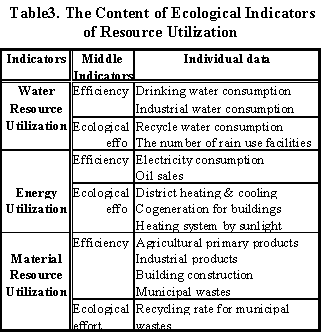2. Resource Utilization Healthiness Indicator (RUHI)

2.1 purpose
RUHI is developed as easy indicator to evaluate local environmental performance in aspect of sustainability under the regional environmental plan. It has already been adopted to Adachi Ward’s “Action program to create local environment gentle to the earth”, Miyagi Prefecture’s “Environment Management Plan”, and Chiba City’s “Environment Basic Plan”.
2.2 content
The component of RUHI is based on Urban Ecology Indicator (UEI) designed by Environmental Agency(1988). It have six middle indicators which is consist of “efficiency” and “ecological effort” groups by each environmental elements; water, energy, material. Efficiency indicators are presented by resource utilization per human activity, and ecological effort indicators are presented by the rate of reuse and renewal resource consumption in total utilization(table 3).
1.3 method
First, standardized individual data scores of each cities based on all Japan mean and standard deviation are calculated. Individual data is aggregated to middle indicators. Individual data which belong to efficiency group is weighted by the quantity or price of consumption, and which belong to ecological effort group is weighted by the saving rate of water or energy. It has been calculated in prefecture level at 1970, 1980, 1990.
Figure 6 Water Efficiency(1990)